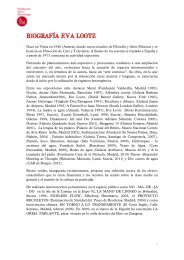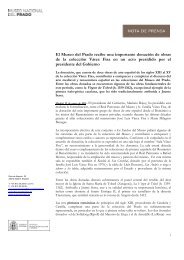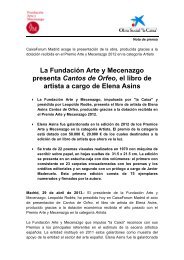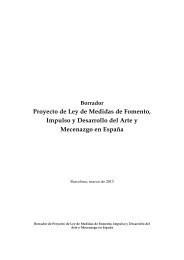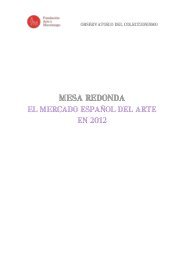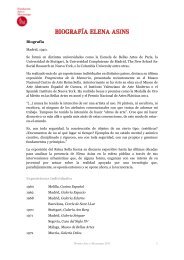BIOGRAFÍA ELENA ASINS - Fundación Arte y Mecenazgo
BIOGRAFÍA ELENA ASINS - Fundación Arte y Mecenazgo
BIOGRAFÍA ELENA ASINS - Fundación Arte y Mecenazgo
Create successful ePaper yourself
Turn your PDF publications into a flip-book with our unique Google optimized e-Paper software.
Frequency-weighted filter465eŒect variable G was therefore introduced into the regression analysis, with data fromthe current study coded as Ð 1 and the pilot data coded as 1. The resulting discomfortmodel was:D 5 10 (2 0.0461 0.393 logE1 0.225 logA1 0.275 logF1 0.047 G) 2 1(r 2 = 0× 930, F(4, 18) = 60× 196,p < 0× 01), where D was discomfort (on a scale between 0and 10), E was exertion level (N), A was wrist ¯ exion angle (8 ), and F was frequency(Hz), which is the inverse of pace. The pure error test revealed that there was nosigni® cant lack of ® t for this linear regression model (F (16,2) = 0× 574, p > 0× 05).Equal discomfort strata were determined by solving the discomfort model forwrist ¯ exion angles as a function of frequency and exertion at a given discomfortlevel (Radwin et al. 1994). The strata for a discomfort level of 3× 5 are shown in ® gure2 with exertion contours plotted against frequency and wrist ¯ exion angle. Taskswith combinations of exertion, wrist ¯ exion and frequency corresponding to thesecurves will result in the same level of discomfort.2.2. Model validation using published data2.2.1. Data from Snook et al. (1995): Snook et al. (1995) used the method ofadjustment to estimate maximum acceptable force for a repetitive wrist ¯ exion task.Fifteen female subjects from an industrial population were instructed to work as hardas they could without developing `unusual discomfort’ at the end of a 7-h session byselecting the maximum acceptable force for wrist ¯ exion between 458 above and belowthe horizontal at various levels of repetition. Data from that study were substitutedinto the current study discomfort model by (1) converting paces into frequencies, (2)using maximum acceptable force as the exertion levels, and (3) assuming a 908 wrist¯ exion for all conditions. Since the discomfort model is logarithmic, expecteddiscomfort levels were estimated by taking the geometric mean discomfort levelsamong groups. The expected discomfort levels are summarized in table 3.Figure 2. Equal discomfort strata for discomfort level 3× 5. Maximum acceptable discomfortstrata for 90% of the female subjects in Snook et al. (1995) and Marley and Fernandez(1995).



